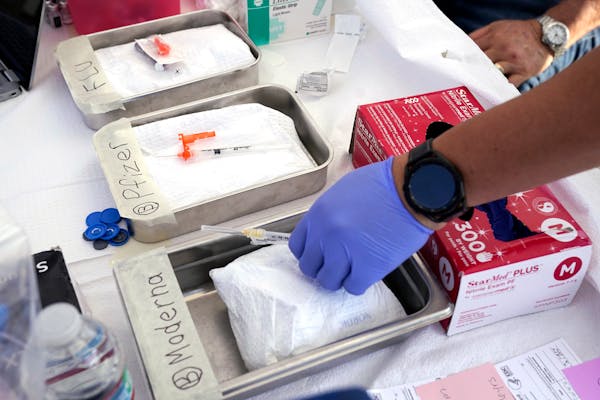Minnesota health officials are hopeful that new testing and vaccine options can help keep relatively low COVID-19 levels from rising.
Dr. Brooke Cunningham, state health commissioner, is urging the majority of Minnesotans who are overdue for COVID vaccinations to take advantage of newly approved doses, which are formulated against a widely circulating strain of the coronavirus.
"The newly authorized, updated vaccines are an even more effective tool," she said.
COVID levels have rebounded a bit in Minnesota after reaching lows just before the July 4 holiday, according to Thursday's state pandemic update. The 189 hospitalizations related to the infectious disease in Minnesota on Tuesday made up the highest total since April 24, and included 23 patients requiring intensive care.
The total remains far below the the pandemic record of 1,864 hospitalizations in November 2020, before vaccines were available, or even the 436 hospitalizations on this date last year. But doctors said the illnesses caused by the latest viral variants are packing a punch.
"I took care of a man, maybe two weeks ago, and he was like, 'This is the fourth time I've had it and this was the worst,'" said Dr. Jean Watson, an internal medicine specialist at Abbott Northwestern Hospital in Minneapolis. "He has chosen not to be vaccinated but this was the first time he was hospitalized … and he was like, 'Why do I feel so badly?' Well, because you have COVID."
Public health officials worry that the start of the school year could spread the virus among children. The kids can then infect their parents or older adults who are more likely to suffer severe COVID illnesses. However, wastewater monitoring for signs of the coronavirus are showing little evidence of a surge in Minnesota.
Viral levels increased slightly in some regions of the state Sunday, but edged lower in the metro area and northeast Minnesota, according to an update Thursday on the University of Minnesota's COVID wastewater dashboard. The website now includes results of sewage sampling from the Metropolitan Wastewater Treatment Plant in St. Paul, which serves most of the Twin Cities population and is no longer reporting its own results.
Sewage sampling is considered a key predictor of COVID trends now that Minnesota is no longer collecting and reporting as many test results from clinics and hospitals. The state last week offered a new round of free at-home COVID tests, the results of which are not collected or reported publicly.
Minnesota's public health lab has continued to sample a portion of positive test results to monitor for changes in COVID activity. The latest surveillance through mid-July showed the emergence of the EG.5 strain of the coronavirus and two XBB strains other than the one on which the new COVID-19 vaccines are based.
Federal health officials approved the new Moderna and Pfizer vaccines earlier this week based on indications that they would still offer protection against the latest strains and reduce risks of severe illness, hospitalization and death.
Minnesota is nearing 15,000 COVID-19 deaths, hitting 14,964 on Thursday. The state's COVID death rate has remained at or near record lows this summer — with the risk being greatest among the elderly. Of the 49 COVID-19 deaths reported in Minnesota since July 30, 43 have been among people 65 and older.
Wolves vs. Nuggets is set. Here's everything we know about Round 2.

Gun safety bills may hinge on one senator's fate despite House support, likely passage

At the U, another pro-Palestinian protest camp goes up

Falcon Heights, St. Anthony nearing police partnership severed after Philando Castile's killing

